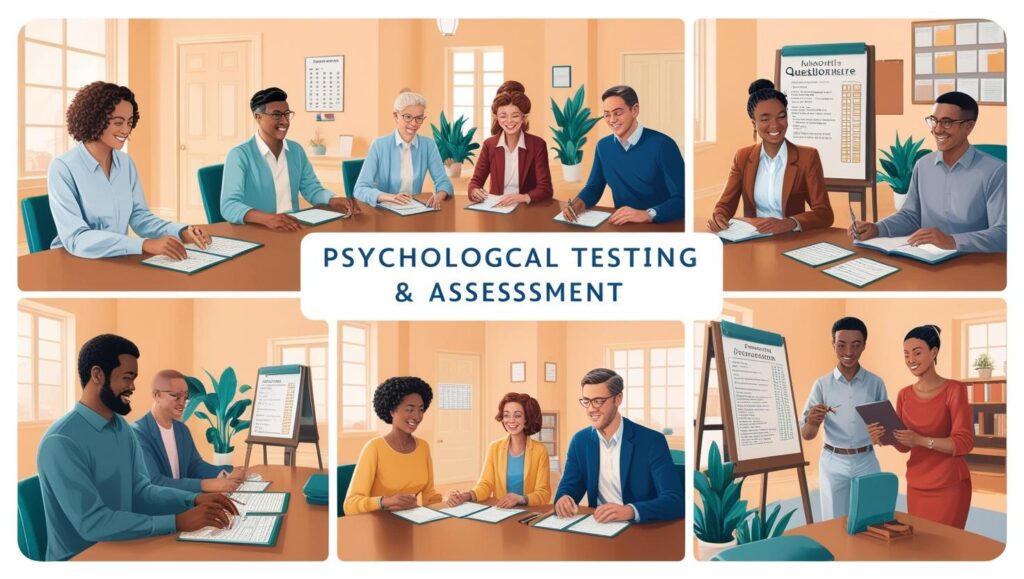

Introduction.
All fields of human endeavor use measurement in some form, and each field has its own set of measuring tools and measuring units. For example, if you’re recently engaged or thinking about becoming engaged, you may have learned about a unit of measure called the carat. If you’ve been shopping for a computer, you may have learned something about a unit of measurement called a byte. As a student of psychological testing and assessment, you need a working familiarity with some of the commonly used units of measure in psychology and a knowledge of some of the many measuring tools employed , we will see through psychological testing and assessment.
Every day, throughout the world, critically important questions like these are addressed through the use of tests. The answers to these kinds of questions are likely to have a signifi cant impact on many lives.This is why psychological testing and assessment plays a vital role in various professional field including education, health and organizational settings.
If they are to sleep comfortably at night, assessment professionals must have confi dence in the tests and other tools of assessment they employ. They need to know, for example, what does and does not constitute a “good test.” Our objective in this chapter is to overview the elements of a good test. As background, we begin by listing some basic assumptions about assessment. Here are some basic principles of psychological testing and assessment that makes a test more reliable and valid, resulting in increasing their efficiency. A deep understanding of psychological testing and assessment ensures that professionals can make informed and ethical decisions based on accurate data.
Principles of Psychological testing and assessment.
Principle 1: Psychological Traits and States Exist
A trait has been defined as “any distinguishable, relatively enduring way in which one individual varies from another” (Guilford, 1959, p. 6). States also distinguish one person from another but are relatively less enduring (Chaplin et al., 1988). The trait term that an observer applies, as well as the strength or magnitude of the trait presumed to be present, is based on observing a sample of behavior. Samples of behavior may be obtained in a number of ways, ranging from direct observation to the analysis of self report statements or pencil-and-paper test answers.These samples are essential components in psychological testing and assessment which aims to understand and quantify such individual differences .
Few people deny that psychological traits exist. Yet there has been a fair amount of controversy regarding just how they exist. For example, do traits have a physical existence, perhaps as a circuit in the brain? Although some have argued in favor of such a conception of psychological traits (Allport, 1937; Holt, 1971), compelling evidence to support such a view has been difficult to obtain. For our purposes, a psychological trait exists only as a construct —an informed, scientific concept developed or constructed to describe or explain behavior. We can’t see, hear, or touch constructs, but we can infer their existence from overt behavior. In this context, overt behavior refers to an observable action or the product of an observable action, including test- or assessment-related responses observed during psychological testing and assessment.
Principle 2: Psychological Traits and States Can Be Quantified and Measured
Having acknowledged that psychological traits and states do exist, the specific traits and states to be measured and quantified need to be carefully defined. Psychological testing and assessment allows researchers and professional to standardize these definitions for practicle use.Test developers and researchers, much like people in general, have many different ways of looking at and defining the same phenomenon. Just think, for example, of the different ways a term such as aggressive is used. We speak of an aggressive salesperson, an aggressive killer, and an aggressive waiter, to name but a few contexts. In each of these different contexts, aggressive carries with it a different meaning. If a personality test yields a score purporting to provide information about how aggressive a test taker is, a first step in understanding the meaning of that score is understanding how aggressive was defined by the test developer.through psychological testing and assessment .
Principle 3: Test-Related Behavior Predicts Non-Test-Related Behavior
Many tests involve tasks such as blackening little grids with a pencil or simply pressing keys on a computer keyboard. The objective of such tests typically has little to do with predicting future grid-blackening or key-pressing behavior. Rather, the objective of the test is to provide some indication of other aspects of the examinee’s behavior through the process of psychological testing and assessment.
For example, patterns of answers to true–false questions on one widely used test of personality are used in decision making regarding mental disorders. This highlights the real world impact of psychological testing and assessment.
The tasks in some tests mimic the actual behaviors that the test user is attempting to understand. By their nature, however, such tests yield only a sample of the behavior that can be expected to be emitted under non test conditions. The obtained sample of behavior is typically used to make predictions about future behavior, such as work performance of a job applicant. In some forensic (legal) matters, psychological testing and assessment may be used not to predict behavior but to postdict it—that is, to aid in the understanding of behavior that has already taken place. For example, there may be a need to understand a criminal defendant’s state of mind at the time of the commission of a crime. It is beyond the capability of any known testing or assessment procedure to reconstruct someone’s state of mind. Still, behavior samples obtain during psychological testing and assessment may shed light, under certain circumstances, on someone’s state of mind in the past. Additionally, other tools of psychological testing and assessment—such as case history data or the defendant’s personal diary during the period in question—might be of great value in such an evaluation.
Principle 4: Tests and Other Measurement Techniques Have Strengths and Weaknesses
Competent test users understand a great deal about the tests they use. They understand, among other things, how a test was developed, the circumstances under which it is appropriate to administer the test, how the test should be administered and to whom, and how the test results should be interpreted. Competent test users understand and appreciate the limitations of the tests they use as well as how those limitations might be compensated for by data from other sources. All of this may sound quite commonsensical, and it probably is. Yet this deceptively simple assumption—that test users know the tests they use and are aware of the tests’ limitations—is emphasized repeatedly in the codes of ethics of associations of assessment professionals.
Principle 5: Various Sources of Error Are Part of the Assessment Process
In everyday conversation, we use the word error to refer to mistakes, miscalculations, and the like. In the context of assessment, error need not refer to a deviation, an oversight, or something that otherwise violates expectations. To the contrary, error traditionally refers to something that is more than expected; it is actually a component of the measurement process. More specifically, error refers to a long-standing assumption that factors other than what a test attempts to measure will influence performance on the test. Test scores are always subject to questions about the degree to which the measurement process includes error. For example, an intelligence test score could be subject to debate concerning the degree to which the obtained score truly refl ects the examinee’s intelligence and the degree to which it was due to factors other than intelligence. Because error is a variable that must be taken account of in any assessment, we often speak of error variance, that is, the component of a test score attributable to sources other than the trait or ability measured.
Principle 6: Testing and Assessment Can Be Conducted in a Fair and Unbiased Manner
If we had to pick the one of these seven assumptions that is more controversial than the remaining six, this one is it. Decades of court challenges to various tests and testing programs have sensitized test developers and users to the societal demand for fair tests used in a fair manner. Today, all major test publishers strive to develop instruments that are fair when used in strict accordance with guidelines in the test manual. However, despite the best efforts of many professionals, fairness-related questions and problems do occasionally arise. One source of fairness-related problems is the test user who attempts to use a particular test with people whose background and experience are different from the background and experience of people for whom the test was intended. Some potential problems related to test fairness are more political than psychometric. For example, heated debate on selection, hiring, and access or denial of access to various opportunities often surrounds affirmative action programs. In many cases, the real question for debate is not “Is this test or assessment procedure fair?” but rather “What do we as a society wish to accomplish by the use of this test or assessment dure?” In all questions about tests with regard to fairness, it is important to keep in mind that tests are tools.
And just like other, more familiar tools (hammers, ice picks, wrenches, and so on), they can be used properly or improperly.
Principle 7: Testing and Assessment Benefit Society
At first glance, the prospect of a world devoid of testing and assessment might seem appealing, especially from the perspective of a harried student preparing for a week of midterm examinations. Yet a world without tests would most likely be more a nightmare than a dream. In such a world, people could present themselves as surgeons, bridge builders, or airline pilots regardless of their background, ability, or professional credentials. In a world without tests or other assessment procedures, personnel might be hired on the basis of nepotism rather than documented merit. In a world without tests, teachers and school administrators could arbitrarily place children in different types of special classes simply because that is where they believed the children belonged. In a world without tests, there would be a great need for instruments to diagnose educational difficulties in reading and math and point the way to remediation. In a world without tests, there would be no instruments to diagnose neuropsychological impairments. In a world without tests, there would be no practical way for the military to screen thousands of recruits with regard to many key variables.
Considering the many critical decisions that are based on testing and assessment procedures, we can readily appreciate the need for tests, especially good tests. And that, of course, raises one critically important question .
Conclusion.
The principles of psychological testing and assessment provide the foundation for their validity, reliability, and ethical use. These assumptions—such as the belief that psychological traits and states can be measured, that test scores remain relatively stable over time, and that assessments are free from significant bias—highlight the importance of proper test construction and interpretation. Ultimately, these assumptions ensure that psychological tests serve as accurate, fair, and useful tools for evaluating individuals in various contexts, including education, clinical settings, and employment. However, test users must be aware of potential limitations and biases, applying assessments with professional judgment and ethical responsibility.
Hope you like the post, do check another article on ‘Psychoanalytic Therapy- Goals and assumptions‘.

Pingback: Psychoanalytic therapy- 6 Goals with Assumptions for Healing